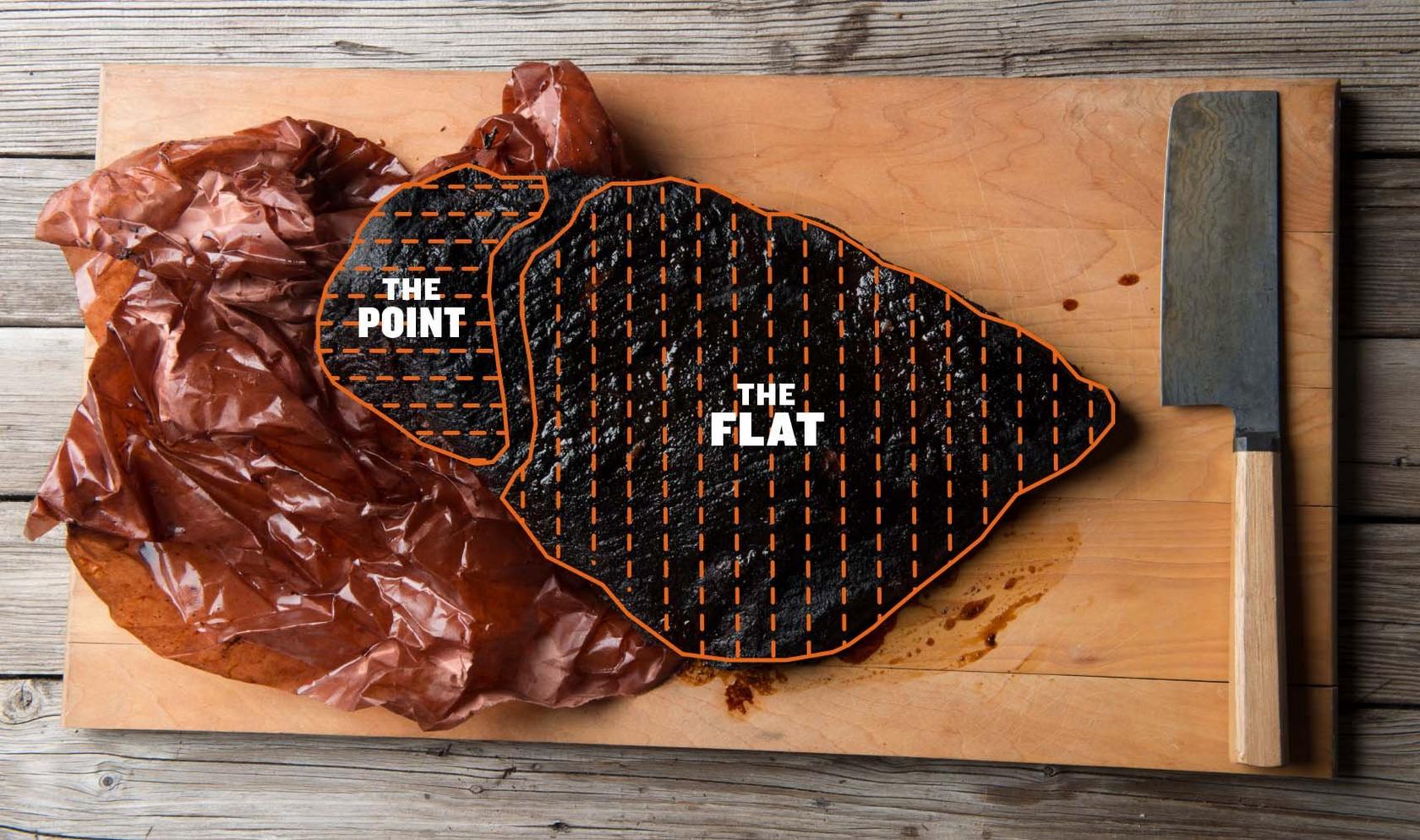
When cooked right, a brisket is hard to beat. But one wrong cut and all the masterful work on the grill is ruined. Knowing how to slice brisket correctly is essential.
A complete full packer brisket is taken from the lower chest of the animal and made of two main parts:
The point is a fattier cut of meat that might be harder to find in supermarkets. This portion is often chopped since it can be difficult to slice through meat so tender.
The flat is usually what you’ll find if you’re getting a pre-cut brisket. The flat is a leaner cut of meat and is best served sliced. Cut properly, that is. Read further to learn how to do it right.
Fat Content of Brisket
A good brisket cut has visible marbling. That’s where most of the juice and flavor will come from. But it also helps to leave roughly one-quarter inch of fat on the outside before you cook your brisket to ensure a good level of juiciness and flavor. Trim excess fat with a sharp slicing knife or boning knife. Ideally, trim while the brisket is still cold, and the fat is more solid and easier to cut through.
The key task we want to go over is cutting the meat after your brisket is cooked. Thankfully it’s not rocket science. With these tips in mind, you’ll learn how to cut a brisket like the best of ‘em.
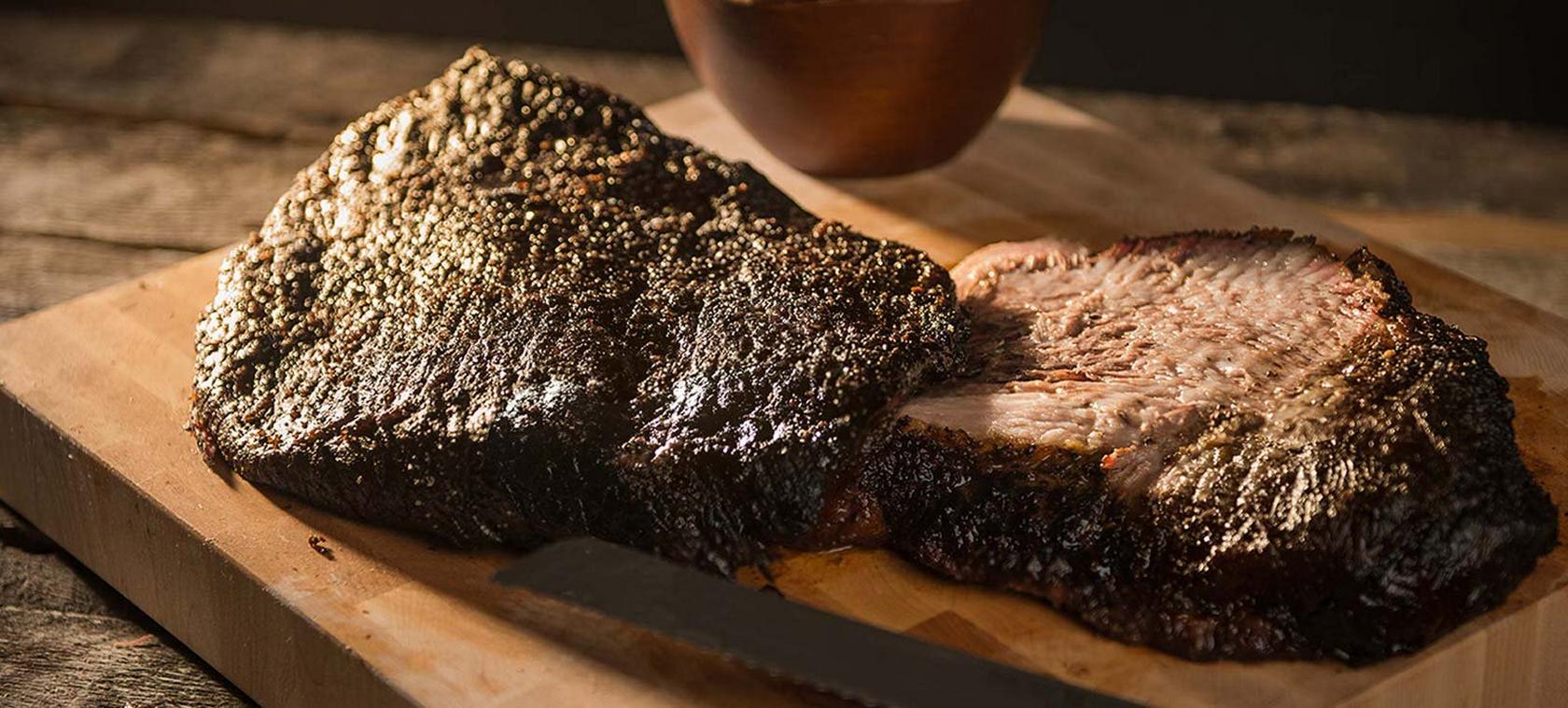
Brisket Cutting Tools
To properly prepare a brisket, you'll need a few essential tools:
- A sharp boning or chef's knife for trimming fat and achieving clean cuts. Long and serrated is best.
- A sturdy cutting board large enough for your brisket -- especially if you're cooking a full packer.
- If you plan on shredding the brisket, make sure to have quality meat claws or forks for handling the brisket.
- A MEATER thermometer to ensure your brisket reaches the ideal internal temperature for tender, juicy results. Pro Tip: Before you get started on cutting your brisket, make sure you let it rest for around 20-30 minutes after removing it from your grill. This will help the meat's internal juices to redistribute for ultimate texture and taste.
How to Cut Brisket
Cutting your brisket after smoking it is a simple, but essential process. Watch our video below and follow along for the best results.
Step 1: Let It Rest
When you pull your brisket off the grill (fully cooked at about 195-205 degrees Fahrenheit internal temperature), the first step is to let it rest for at least 1 hour - you can let it rest up to 3 hours. According to Traeger’s BBQ expert Chad Ward, “Allowing brisket to rest lets juice redistribute throughout the meat. If sliced right off the grill, the meat would lose moisture.” The best way to keep track of your internal temperature is with a MEATER wireless meat thermometer
Step 2: Choose the Right Knife
While we wait for the meat to rest, let’s talk about potential brisket knives.
You want a blade that’s long, sharp, and serrated so that you can cut most or all of the meat at once. The serrated edge also helps saw through the tough parts of the meat. Doug Scheiding’s recommended knife to trim is a 14-inch slicer. Find a good, sharp knife with a weight that feels good in your hand.
Step 3: Find the Grain
Above all else, the important thing is the direction of your cut. You want to cut against the grain. As mentioned above, the brisket has two parts which can make this a little tricky, but nothing you can't tackle.
The grain of any meat is the alignment of muscle fibers. When intact, the muscle fibers are strong and chewy. If you don’t cut against the grain, the muscle fibers will remain somewhat intact and very difficult to chew. When you cut against the grain, you break up the muscle fibers evenly so that the meat becomes much more tender in every slice.
Before cooking, we recommend cutting a corner of the flat as it is easier to see the grain when the meat is uncooked. Use that corner to help you find the direction when the brisket is done and ready to be sliced.
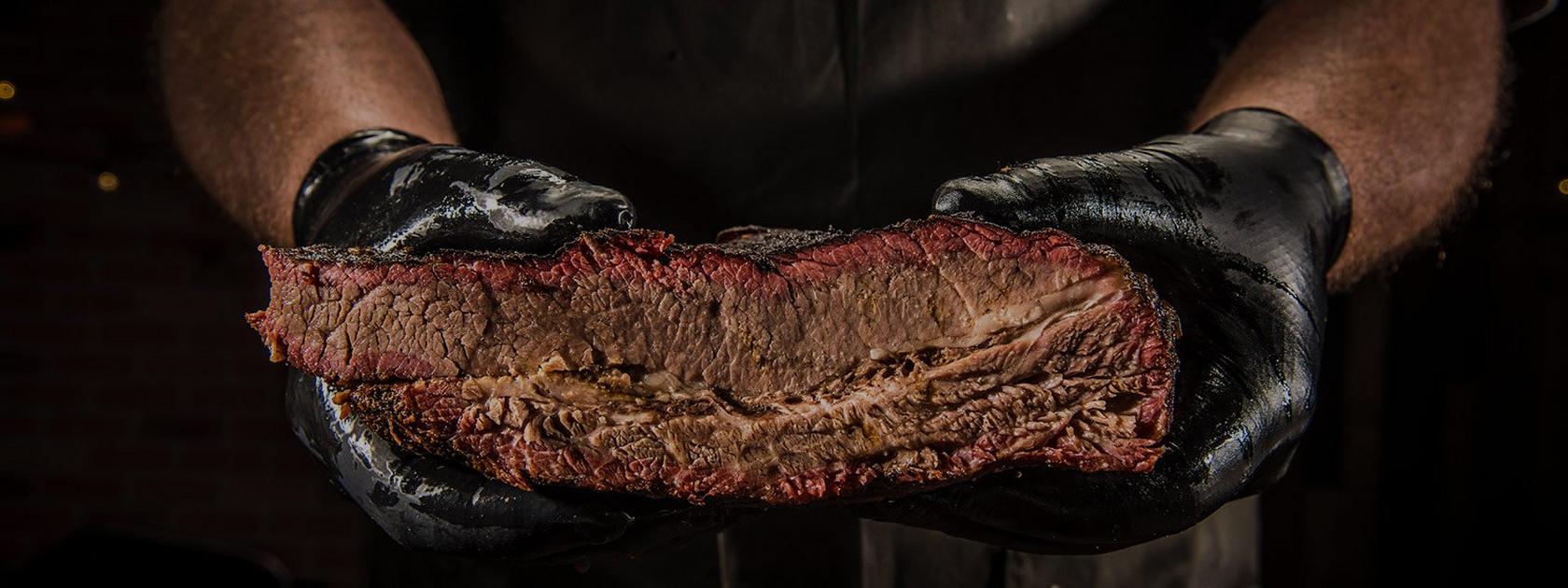
Step 4: Cut — Firmly but Gently
First, trim any excess fat from the side if you haven’t already trimmed them while prepping your brisket.
You want to cut against the grain (or across) at a 90-degree angle starting with the flat.
Once you start to get to the middle of the meat, you’ll start to see two layers of muscle (see image above) – this is the point cut of the meat. Stop cutting. The direction of the grain has changed. Rotate your meat about 90 degrees so you can cut against the grain of the point cut.
If you’re not sure how to cut a brisket against the grain, start with the flat end of the brisket, cutting slices just shy of one-half inch.
You don’t want to cut down directly like you would a piece of cheese, but you’re not quite sawing through a two-by-four either. The meat should be tender enough that you can gently saw through it while slicing down – as you would through a soft loaf of fresh-baked bread. You want the slices to be the width of a #2 pencil as Aaron Franklin recommends.
Brisket Grain Diagram
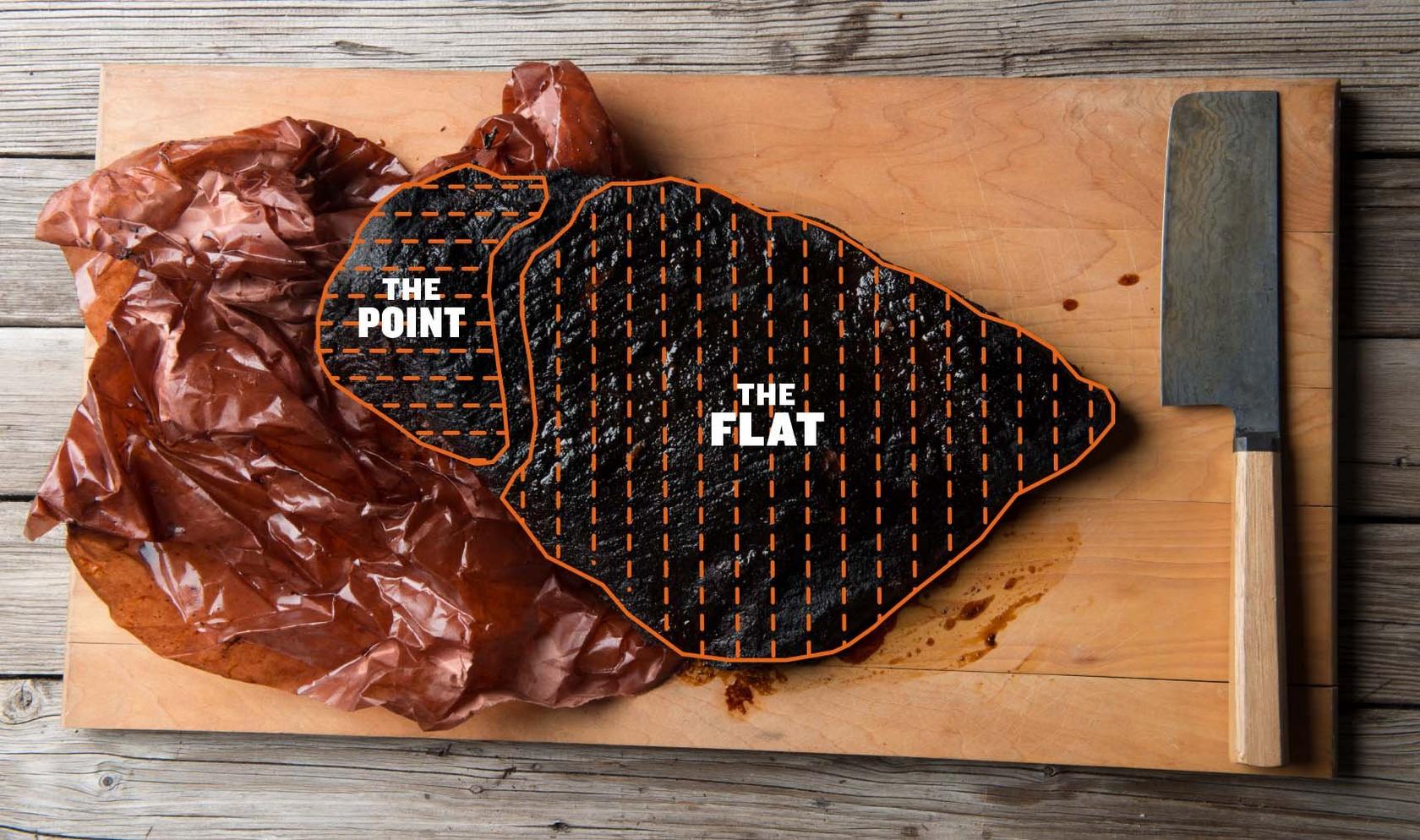
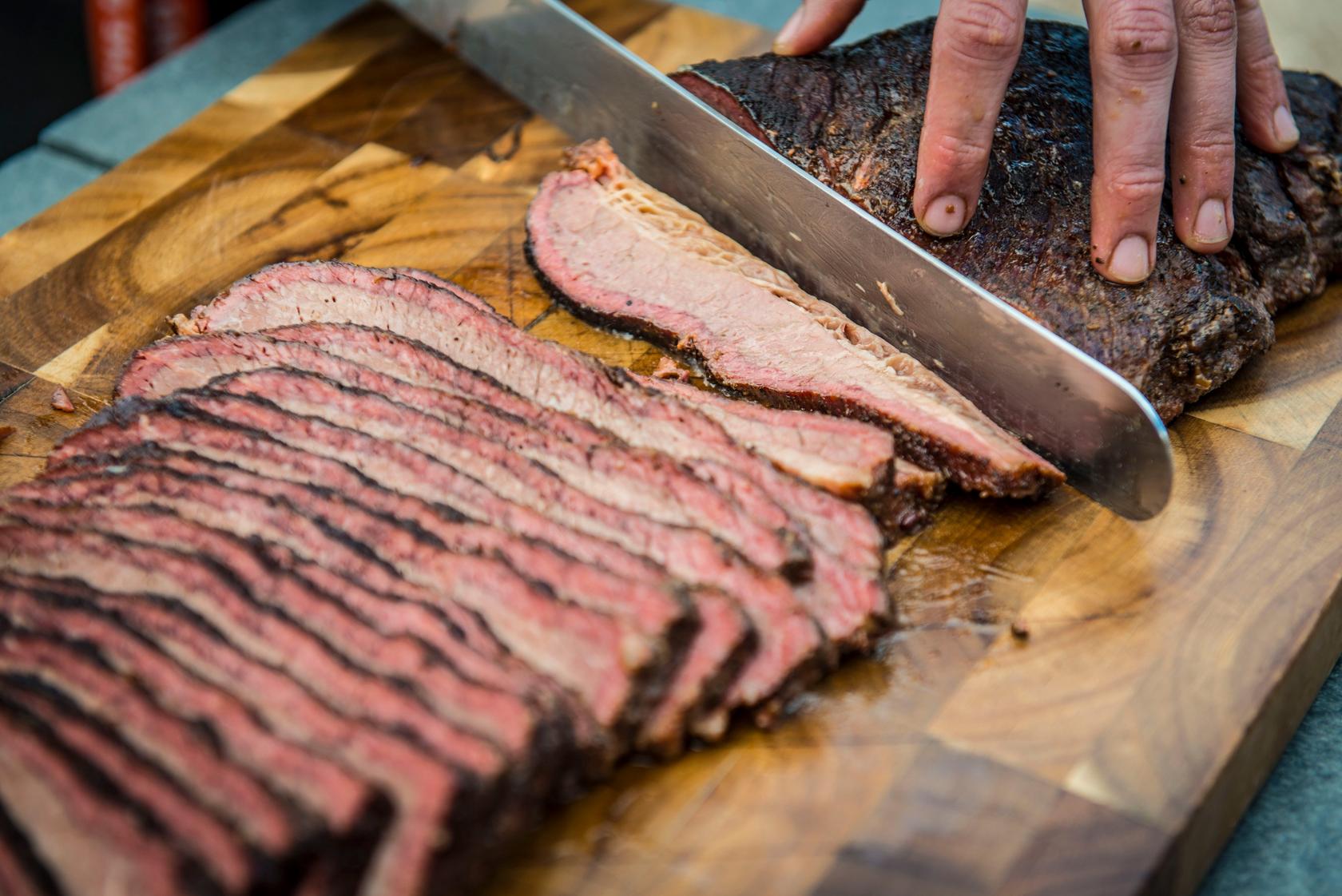
Step 5: Harvest the “Burnt Ends”
Also known as “meat candy,” your first and last cuts are too small to slice the same as the rest, but don’t let these tasty morsels go to waste!
There’s plenty of juicy flavor packed in the burnt ends. Check out our more detailed guide on how to make brisket burnt ends. It’s hard to cut against the grain with these pieces, but they should still be tender since they’ve been separated from the rest of the meat. Cut them into chunks and serve them with the rest, or reserve them for those who deserve a special treat — like you! Check out some of the delicious burnt ends recipes our Ambassadors and Chefs have created:
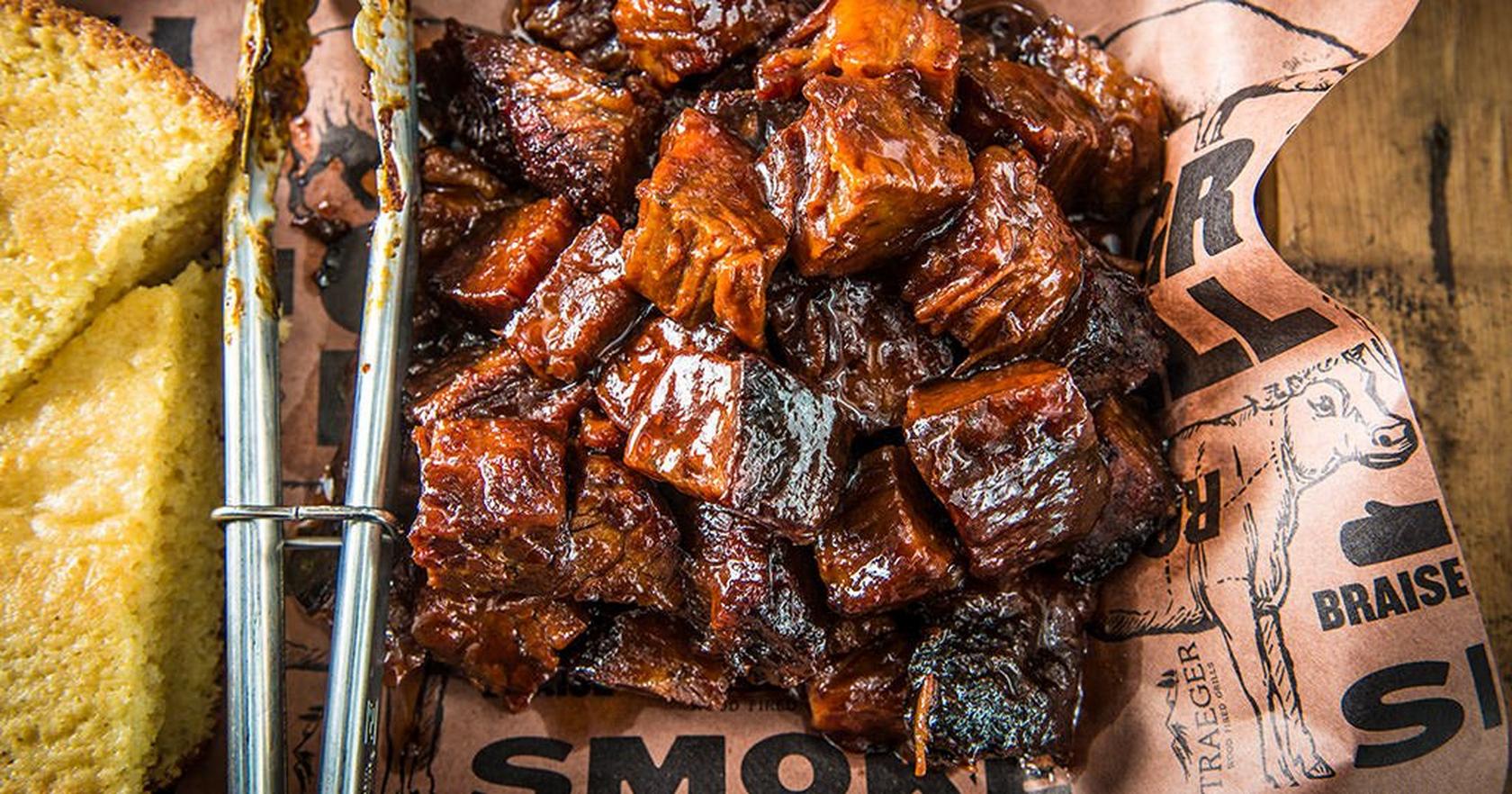
Plan B: Chopped Brisket
Cutting brisket shouldn’t be much harder than slicing a loaf of bread, but sometimes things don’t go as planned.
Or you might be one of many grillers that prefers to reserve the point for a different purpose than the rest of the brisket because it’s a fattier cut of meat. Whatever the case may be, you can always bust out the cleaver and give everything a good, rough, chop.
Chopped brisket is a common BBQ favorite that’s especially delicious in sandwiches, tacos, chili, and even a brisket pot pie.
It’s usually good to cut the super-rich flavor of chopped brisket with something that’s a little acidic, like vinegar, fresh-squeezed lime, or your favorite BBQ sauce.
Just don’t forget to go against the grain so that you don’t have any chewy chops! The meat might be falling apart a bit too much to make the same precise cuts you would with the flat, but you want to have consistent texture in your chopped brisket. So for the initial chops, try to stick to 90-degree cut against the grain.
It’s your BBQ and your rules, so going against the grain doesn’t just apply to how you cut it, but also how you flavor it. Feel free to browse all of our brisket recipes and let us know what sort of flavor combinations work best for you!
Texas-Style Smoked Beef Brisket by Doug Scheiding
by Doug Scheiding
86 Reviews
Prep Time
30 Min
Cook Time
18 Hr
Serves
6
Pellets
Cherry
This is the best way to smoke a brisket, worthy of any true Texan. This full packer is injected with Butcher’s Prime, sprayed down with apple juice, rubbed with a prime rib and coffee rub mix, topped with black pepper, and smoked over cherry wood to tender perfection.
Ingredients
main
| 1 | (12-15 lb) whole packer brisket |
| 2/3 Cup | Butcher BBQ Prime Brisket Injection |
| 2 Cup | water |
| 2 Tablespoon | Canola oil |
| 1 1/2 Cup | apple juice |
| 1/2 Cup | Traeger Prime Rib Rub |
| 1/2 Cup | Traeger Coffee Rub |
| 2 Tablespoon | freshly ground black pepper |
1
Trim the fat cap off the top of the brisket and remove all silverskin. Trim off any brown areas around the sides of the brisket. Make a long cut with the grain on the flat (thin) side of the brisket and a short cut again on the flat to show the direction of cuts after cooking. Trim the bottom fat cap to about 1/4 inch thick.
2
In a large liquid measuring cup, combine the Butcher BBQ Prime Brisket Injection and water. Use a meat injector to inject the mixture into the brisket with the grain in a checkerboard pattern. Rub the entire brisket with canola oil, then spritz with apple juice and let sit for 30 minutes. Reserve the remaining injection mixture.
3
When ready to cook, set the Traeger temperature to 180℉ and preheat with the lid closed for 15 minutes. For optimal flavor, use Super Smoke if available.
4
In a small bowl, combine the Traeger Prime Rib and Coffee Rubs. Season the brisket with the rub mixture, then sprinkle the black pepper over the top.
5
Insert the probe into the thickest part of the brisket. Place the brisket directly on the grill grates, fat-side down. Close the lid and cook until the internal temperature reaches 150-160°F, 8-12 hours, spritzing with apple juice every 30-45 minutes after the first 3 hours.
6
Remove the brisket from the grill and increase the grill temperature to 225°F.
7
Wrap the brisket in a double layer of heavy-duty aluminum foil, leaving one end open. Pour the remaining injection mixture into the foil packet, then seal closed. Return the wrapped brisket to the grill and re-insert the probe. Cook until the internal temperature reaches 204℉, 3-4 hours more.
8
Remove the brisket from the grill and wrap in a towel. Place in an airtight cooler to rest for 2 hours.
9
When ready to serve, transfer the brisket to a large cutting board. If desired, reserve the accumulated injector mixture from the foil packet and separate the liquid from the fat. Slice the brisket against the grain into pieces about the width of a pencil and serve with the reserved juices. Enjoy!